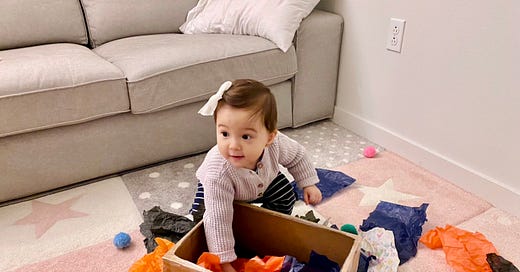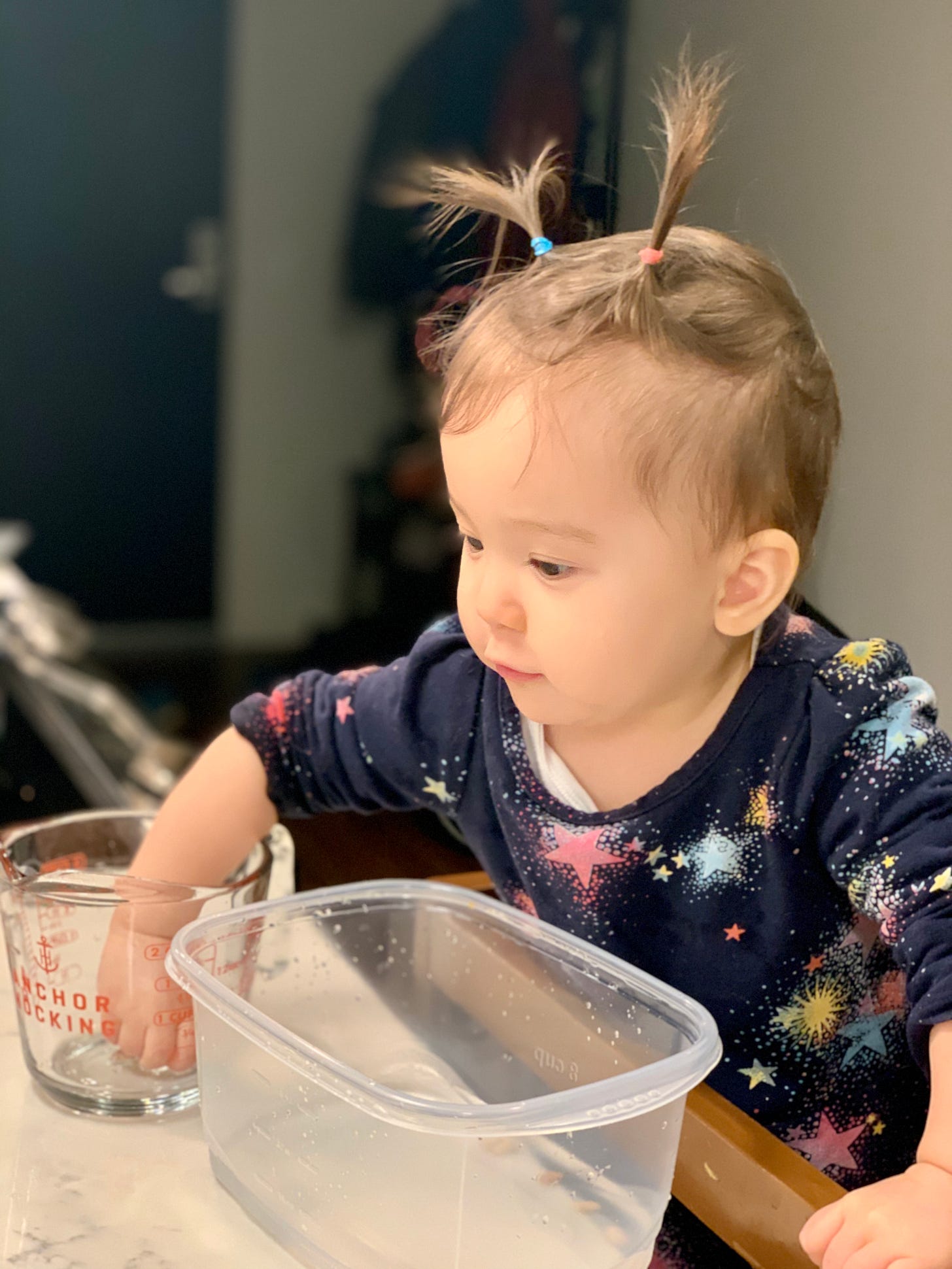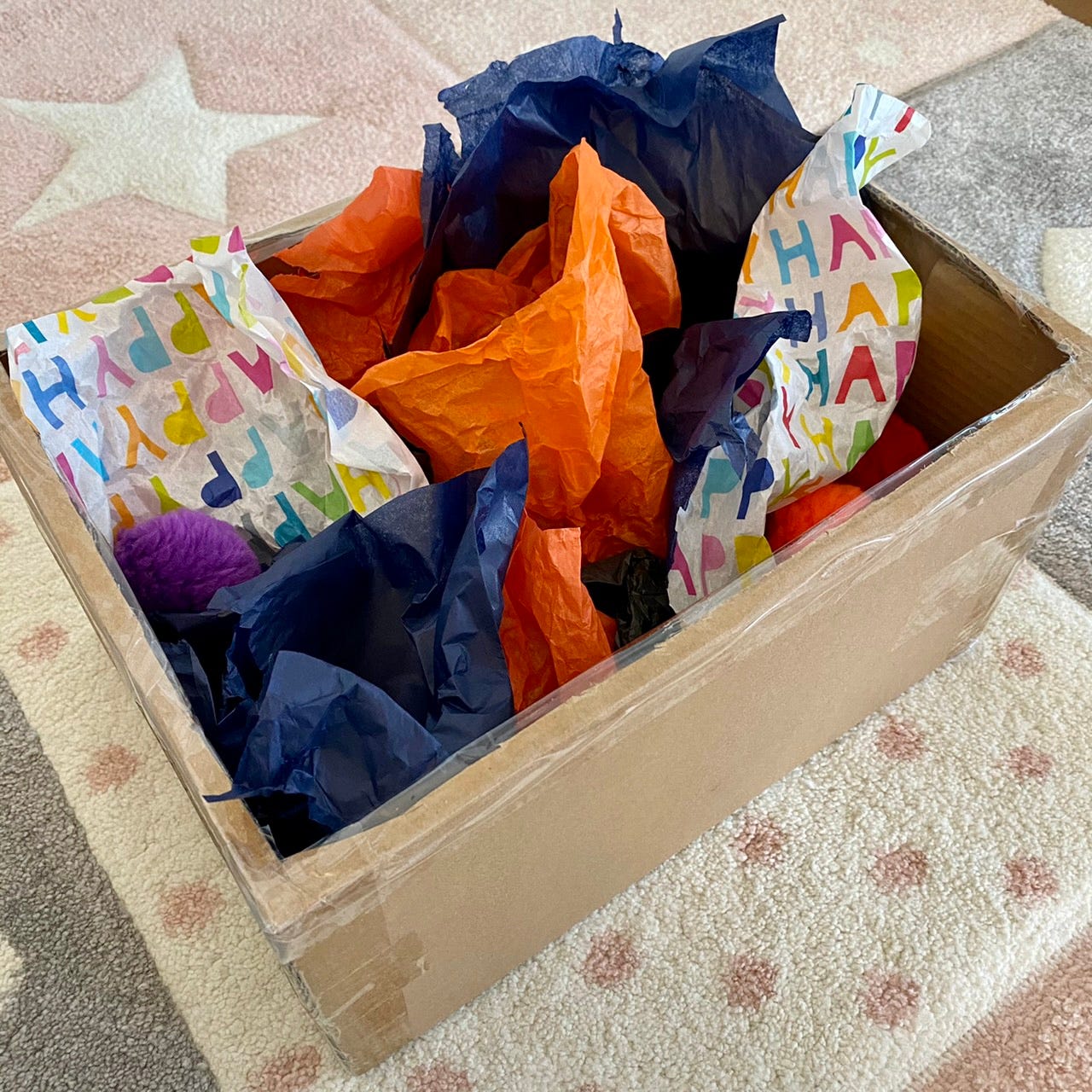Following Your Child
What is the Montessori practice of "following the child?", tissue paper sensory play, and more!
Happy New Year! I hope your 2021 is filled with hope, laughter, and love.
One of my favorite aspects of the Montessori method is the philosophy of following the child on his or her own learning path. While one of the core aspects of Montessori, it is also one of the hardest to really understand. It is a very simple principle, but one that can be easily misunderstood.
Dr. Montessori explained it this way: “Follow the child, they will show you what they need to do, what they need to develop in themselves and what area they need to be challenged in. The aim of the children who persevere in their work with an object is certainly not to ‘learn’; they are drawn to it by the needs of their inner life, which must be recognized and developed by its means.”
Montessori recognizes that children are drawn to activities and materials that they instinctively know they need to work on. Following the child is an acknowledgement that each child has their own pattern of development, and it is our job as parents (or teachers, or caregivers) to observe the child and figure out what they are gravitating to and working on and provide them opportunities to do so. This means we need to take into account their understanding, interests, and level of skill development and use that as our guide when giving our children activities or materials to work with.
Observe, observe, observe!
Observation is a very important part of the Montessori philosophy. In fact, I would say that the philosophy is nothing without observation. In order to understand what and how your child is learning and how you can guide and further their development, you first need to take the time to observe your child daily. Most simply, observation is looking for patterns and meaning in your child’s play. Trying to figure out why they are playing and interested in what they are doing. You can read more about how to observe your child here.
Let your child develop at their own pace.
Montessori leaves room for children to develop skills at their own pace. If a child needs more time in a particular area, we should give the child the time they need to master that skill or concept before moving on to the next skill or concept. For example, if L is highly engaged in putting lids on jars, I allow her to stay absorbed in this activity for as long as her interest is held and she is gaining some information from it. Once she shows a lack of interest in the activity or I have noticed that she has mastered it, there is not reason to make her continue to do it because I think she should learn how to put lids on jars by now. We should also be careful not to push a child to where we think they should be developmentally. It is much more beneficial to offer a child work that is engaging to them.
Freedom within limits!
Following the child does not mean letting your child do whatever they want! Dr. Montessori said to “Follow the child, but follow the child as his leader”. This brings up another core aspect of Montessori: freedom within limits. We can only follow the child when we have first prepared a safe environment that has taken the child’s current development into account. You can read a great article about freedom within limits here.
Practically, what does this look like? Here is a real life example.
Let me give you a recent example with my own daughter. I recently observed that she gravitates toward moving objects back and forth from one container to another. This work is called transferring. At L’s current development level, this work is done with her hands, but as she gets older she will want to do this with cups (pouring), spoons, shovels, tongs, etc. This kind of work improves fine motor skills and hand control and helps with focus and concentration.
I observed this first through finding parts of one toy constantly in another (she kept transferring her wooden pegs from her pop up toy and putting them into her carrot posting box), and noticing her doing it naturally with objects around the house.
I decided to put my theory that this is what she was working on to the test by providing some specific work for this. The first activity I provided for her was taking small stones out of a container and placing them on a lid (with careful observation so she did not try to put any in her mouth). It was an instant hit! My observation was correct!
I then provided her with several similar activities. I had her transfer pasta from one old spice jar to another. I had her transfer beans from one container to another (I added water for added sensory play, see picture above). I had her transfer the food scraps from the counter to the compost bin. She transferred the laundry from the dryer to the basket.
This kind of transferring work is something that she is still interested and engaged in, so I will keeping finding ways for her to expand these skills as she has now mostly mastered transferring with her hands. I am planning on introducing a scoop to bowl bean transferring activity next!
Questions or comments about following your child? Ask me here!
A few resources I am excited to share with you this week:
An article by Theresa of Montessori in Real Life about how Montessori has made parenting fun!
I really can not say enough about this article. Please read it if you are able! Theresa acknowledges how challenging, monotonous, sometimes even boring, and definitely overwhelming raising babies and toddlers can be. Parenting is hard.
She writes about how implementing the Montessori method at home has helped her change her mindset when parenting little ones. She points out seven different ways Montessori has helped her to do this. One way she mentions is observation. She writes “Observation is a key piece of the Montessori philosophy, and I find that the more I observe my children - their new skills, interests, challenges - the more interested I am in their play.”
Another way she mentions that Montessori has made parenting fun is following her children’s own path. She writes that Montessori has taught her that each child is different. They have their own interests, timelines, challenges, and strengths. When we embrace our own child’s path it makes parenting so much more enjoyable!
An article by one of my favorite instagram accounts (@biglittlefeelints)They also have a great toddler behavior course for parents. Tips for preventing screen time meltdowns in Toddlers.
This is a great and short article with steps to take to prevent screen time melt downs with Toddlers. This is something that hits home. Although I really did not want to start screen time with L until she was at least two years old, it happened when she stopped being able to lay still for diaper changes (she also refused to stand).
The basis of the steps is to first prepare your toddler before they begin screen time. Tell them “two episodes of Elmo. One, two, then all done. Bye-bye Elmo”. When your child starts to protest, first identify their feeling; “your sad because you wanted to watch more Elmo. Saying bye to Elmo on the iPad is hard, it is ok to be upset”. Then stick to the boundary. This is important! Follow it up with something positive “it’s time for lunch now, do you want blueberries or kiwi with your pasta?”
A fun sensory activity using holiday left over wrapping paper or tissue paper!
After the holidays, I am sure we all have large amounts of tissue paper or wrapping paper lying around. They actually make a great sensory bin item! L loves tissue paper and paper towels, so I knew this would be something she would love and it is super simple!
All you need is a sensory bin or a box (I used an old box), some wrapping paper (I used tissue paper as I thought it would appeal to L more), and some pompoms.
I simply ripped the tissue paper into pieces and piled in the box with some giant pompoms and let L explore in anyway she wanted. She mostly just threw the tissue paper around, torn it up, and took out the pompoms. These actions worked on her fine motor skills (tearing), gross motor skills (throwing), object permanence (finding the pompoms), and building concentration skills.
If you try this, let me know how your little one enjoys it!






